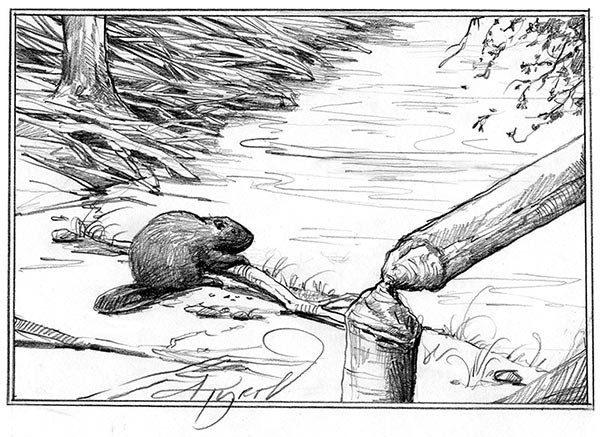
Around a beaver pond, we sometimes catch a whiff of beaver odor. People have described it to me as smoky, woody, or like tobacco. It may waft over from the lodge, or it might emanate from scent mounds – little piles of mud by the water’s edge. Beavers make scent mounds by dredging up mud from the bottom of a pond, then carrying it up on land in their front paws while walking upright. The beaver drops the mud, then squats over the mound and applies castoreum from glands near the base of the tail.
The smell means: keep away! In some neighborhoods, this territorial advertisement works remarkably well. I’ve been involved in studies where human-made scent mounds effectively deterred free-ranging beavers from settling in unoccupied beaver habitat.
When a beaver detects a foreign castor smell in its territory, it implies brazen behavior that has to be dealt with. The residents invariably eliminate the strange scent mark. They paw it apart and scent mark over it. If they come across the perpetrator, they’ll attack viciously. Researchers have found that beavers can identify family members by their castor smell; they can also distinguish between neighbors and complete strangers.
Castoreum contains many different kinds of compounds: alkaloids, phenolics, terpenes, alcohols, and acids among them. The beaver appropriates the ingredients from the plants it eats; ironically, the plants use the compounds to say: keep away!
Plants synthesize a bewildering variety of secondary compounds that differ from the basic classes of proteins, fats, and carbohydrates. Some, like alkaloids, taste bitter, while tannins are astringent. When they work, the compounds defend the plants against mammal and insect herbivores, as well as fungi and other microorganisms. These secondary compounds interfere with digestion and inhibit reproduction. Some are outright toxic and even deadly.
Compounds from a number of trees in the beaver’s diet end up in their castoreum. Benzyl alcohol occurs in aspens and poplars, benzoic acid in black cherry and scots pine, and catechol in common cottonwood. In summer, beavers eat aquatic plants such as pondweed and pond lilies – the alkaloids that these plants use to deter insects also end up in the beaver’s mix.
Beavers cope with plant chemicals in different ways. They have in their saliva a protein that binds tannins and renders them harmless. They deal with other compounds by breaking them down into their component parts: when they ingest salicin – a bitter chemical in willow and poplar bark – the salicin molecule gets broken down into sugar and, eventually, salicylic acid. (Beavers are not the only animals that have this trick – leaf beetles also ingest salicin when munching on willow leaves. They use the glucose as a nutrient and the salicylic acid for defense against predators, such as ants.)
Even humans appropriate beaver castor, though we use it to say: come here! Castor sacs are a secondary product of the fur trade and are sold to perfumers who use the castor to give perfumes an “animal note.” In fact, the chemical investigation of castoreum was driven by the perfume industry.
We’re also not above recycling plant compounds for our own purposes. Salicylic acid is the active principle of aspirin. Over two thousand years ago, physicians in ancient Greece prescribed willow bark to fight fevers and inflammation. Native Americans used willow bark against headaches, and today we still treat pain of the lower back and osteoarthritis with willow bark preparations.
And so there rages a chemical arms race in the woods. Trees bolster their defenses against herbivores, especially during the dormant season. Beavers and other animals defeat these defenses by breaking down, detoxing, sequestering, and recycling potentially harmful compounds. Plotting their next move, trees will crank up their defenses. Two- and three-year old aspen saplings are rich in bitter-tasting salicin-like glycosides. Beavers avoid these and feed on larger, less bitter trees, allowing the young trees to prevail. The race goes on and no one ever wins. Each measure provokes a countermeasure.


Discussion *